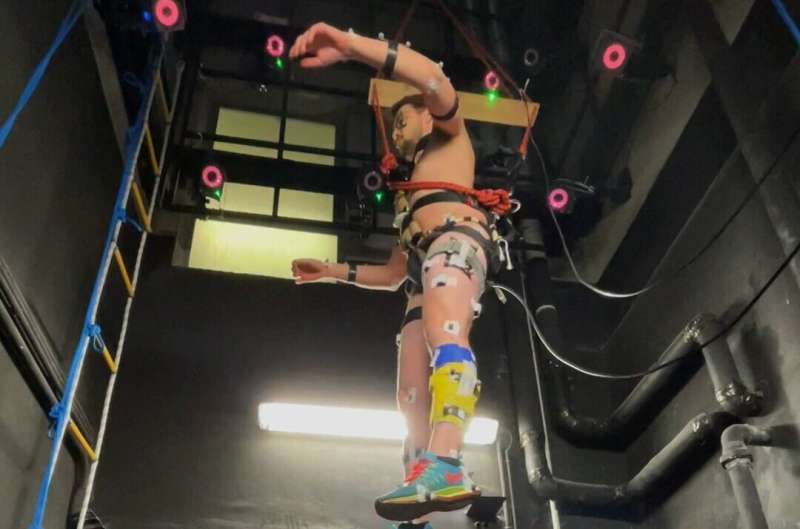Credit: European Space Agency
The videos of the first moon landing with astronauts bouncing around the lunar surface are looking like a lot of fun—but jumping around on the moon could also be good for astronaut's muscles, bones and the cardiorespiratory system.
The "Movement in Low Gravity Environments" (MoLo) program simulates lunar gravity—called hypogravity—on Earth to investigate how human bodies' adapt and a team of space medicine experts at ESA's European Astronaut Center in Cologne, Germany, is investigating how bouncing on the moon could help maintain and even grow healthy bones and muscles.
"We want to generate and expand knowledge on how the human body reacts and adapts to hypogravity to prepare astronauts for future planetary exploration missions," explains Nolan Herssens, post-doctoral research fellow and project leader.
Bouncing for balance
But how can you simulate reduced gravity on Earth? The program had several phases, starting with a refurbished ventilation shaft in ESA's ground based facility "Locomotion On Other Planets" in Milan, Italy. A 17-meters pole was fitted with a bungee rope, allowing a person to do vertical jumps as high as six meters in simulated lunar gravity, and for the team to investigate the movement and its biomechanics.
The second stage involves a parabolic flight, a special flight maneuver that simulates lunar and Mars-like gravity, allowing the team to study the effects of hypogravity on human balance.
Credit: European Space Agency
"Compared to the jumping exercises in Milan, the "Hypo-G" flight affects all our body parts equally, as it would on the moon. We will perform standardized balance tests to study the differences in the physiological systems that help us maintain balance," explains Tobias Weber, science operations engineer and co-supervisor.
Should the study reveal that balance is impaired through reduced gravity levels, the findings will help to define countermeasures aiming at preventing falls and balance problems on lunar, and later martian, terrains.
One small hop for an astronaut
In a future step, the researchers will test if hopping against low levels of loading can be performed on the International Space Station which may in the long term promote bone and muscle growth.
"Bone is very sensitive to mechanical forces and on Earth we generate them through walking every day, which is sufficient to maintain the integrity of our bones and muscles. In microgravity, all this is gone, and we don't know yet if lunar gravity is sufficient to maintain musculoskeletal integrity," explains Tobias.
"Hopping would add a very effective and simple exercise to help astronauts mitigate or even prevent physiological deconditioning. Crew members could also need shorter rehabilitation after their missions than those exposed to permanent microgravity," he adds.
According to the team, it is likely that no additional exercise hardware would be needed if astronauts lived in a lunar habitat. "Contrary to the Space Station, astronauts can walk around on the lunar surface. So, they already have some kind of exercise by doing extravehicular activities (EVAs) or daily tasks. Controlled maximal hopping may be a way to supplement this EVA without requiring any additional equipment," says David Green, co-supervisor from the European Astronaut Center and King's College London.
Credit: European Space Agency
Moon ahead
For further testing on Earth, the team is involved in developing an offloading system for the ESA-DLR LUNA facility, which includes a vertical suspension system that can suspend two people simultaneously to simulate a spacewalk on lunar terrain.
With this pioneering project, the team is expanding and pooling knowledge in research institutions across Europe that are studying the effects of hypogravity on the human body.
"This is an under-explored area and truly applied science. Anything we find out will very likely have an impact on the development of countermeasures and space habitats. I am especially excited to see the transition from low-Earth orbit to deep space exploration," says Tobias.
"There is a lot of work to do in order to prepare for long term habitation on the lunar surface—not least the ergonomics of lunar life. Apollo crews went into and out of their lander in their EVA suits. Walking and moving in lunar gravity without an EVA suit is something that humanity has never done so we don't know what 'normal' lunar movement is—which is critical to optimize EVA suits but also to define ceiling and storage heights, and even things such as lunar stairs for the time when we start to build 'homes' on the surface," David adds.
With a background in physical therapy and neurorehabilitation, Nolan is excited to see the benefits for terrestrial medicine: "The results of the studies will have a direct impact on space travels and any advances we make to propel the human species in space can also potentially be translated to the medical field on Earth, such as using body weight offloading systems for rehabilitation processes after a stroke or surgery."
Provided by European Space Agency
























